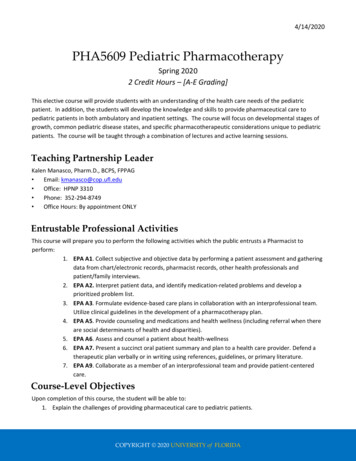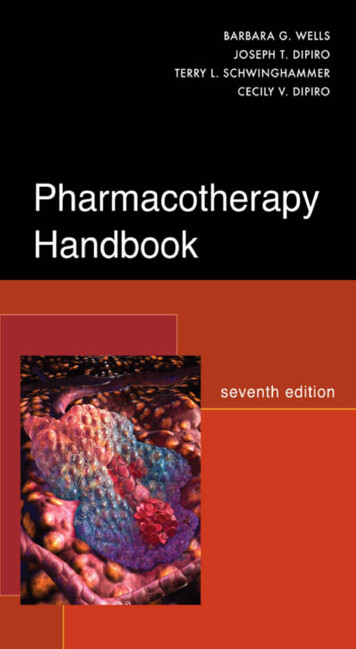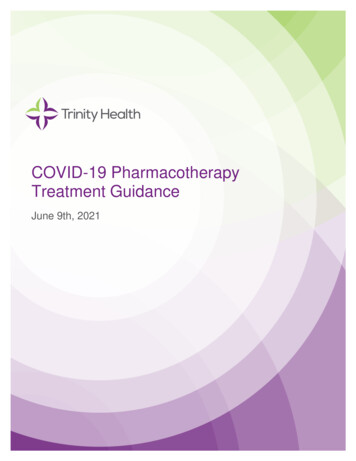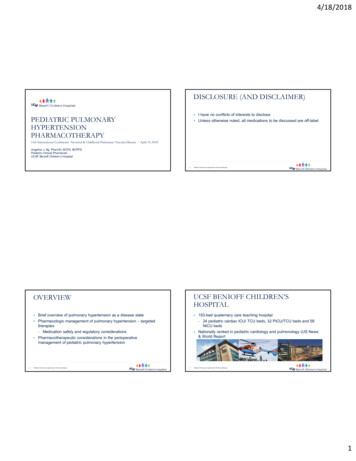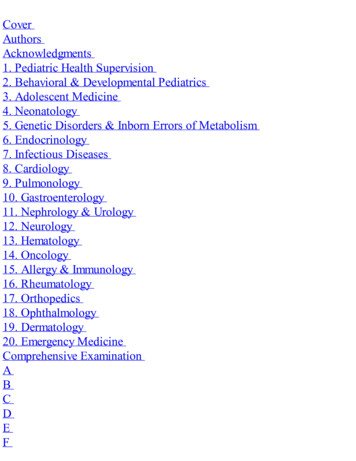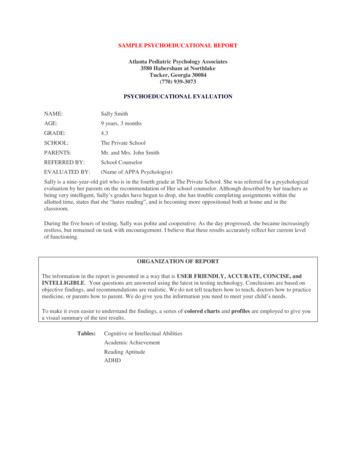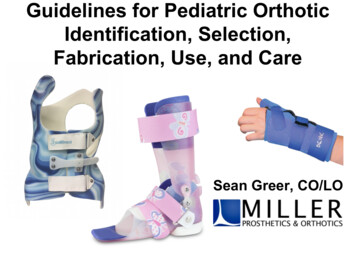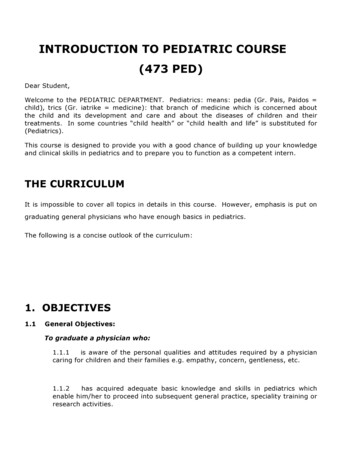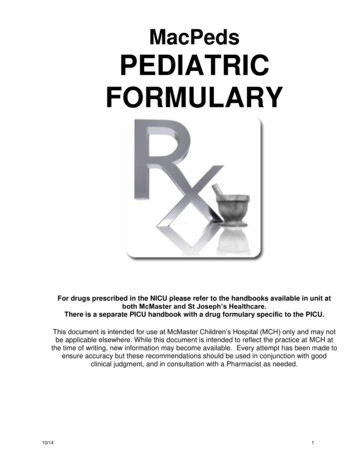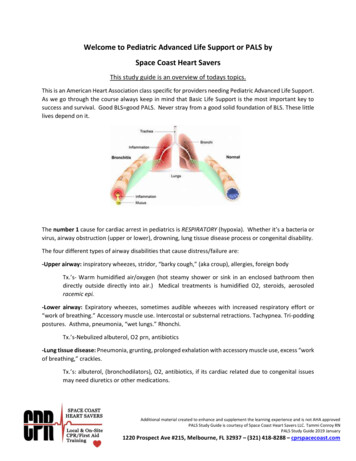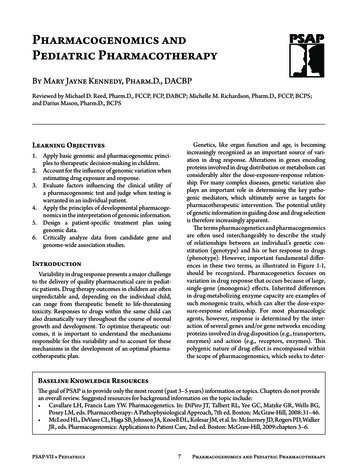
Transcription
Pharmacogenomics andPediatric PharmacotherapyBy Mary Jayne Kennedy, Pharm.D., DACBPReviewed by Michael D. Reed, Pharm.D., FCCP, FCP, DABCP; Michelle M. Richardson, Pharm.D., FCCP, BCPS;and Darius Mason, Pharm.D., BCPSLearning ObjectivesGenetics, like organ function and age, is becomingincreasingly recognized as an important source of variation in drug response. Alterations in genes encodingproteins involved in drug distribution or metabolism canconsiderably alter the dose-exposure-response relationship. For many complex diseases, genetic variation alsoplays an important role in determining the key pathogenic mediators, which ultimately serve as targets forpharmacotherapeutic intervention. The potential utilityof genetic information in guiding dose and drug selectionis therefore increasingly apparent.The terms pharmacogenetics and pharmacogenomicsare often used interchangeably to describe the studyof relationships between an individual’s genetic constitution (genotype) and his or her response to drugs(phenotype). However, important fundamental differences in these two terms, as illustrated in Figure 1-1,should be recognized. Pharmacogenetics focuses onvariation in drug response that occurs because of large,single-gene (monogenic) effects. Inherited differencesin drug-metabolizing enzyme capacity are examples ofsuch monogenic traits, which can alter the dose-exposure-response relationship. For most pharmacologicagents, however, response is determined by the interaction of several genes and/or gene networks encodingproteins involved in drug disposition (e.g., transporters,enzymes) and action (e.g., receptors, enzymes). Thispolygenic nature of drug effect is encompassed withinthe scope of pharmacogenomics, which seeks to deter-1. Apply basic genomic and pharmacogenomic principles to therapeutic decision-making in children.2. Account for the influence of genomic variation whenestimating drug exposure and response.3. Evaluate factors influencing the clinical utility ofa pharmacogenomic test and judge when testing iswarranted in an individual patient.4. Apply the principles of developmental pharmacogenomics in the interpretation of genomic information.5. Design a patient-specific treatment plan usinggenomic data.6. Critically analyze data from candidate gene andgenome-wide association studies.IntroductionVariability in drug response presents a major challengeto the delivery of quality pharmaceutical care in pediatric patients. Drug therapy outcomes in children are oftenunpredictable and, depending on the individual child,can range from therapeutic benefit to life-threateningtoxicity. Responses to drugs within the same child canalso dramatically vary throughout the course of normalgrowth and development. To optimize therapeutic outcomes, it is important to understand the mechanismsresponsible for this variability and to account for thesemechanisms in the development of an optimal pharmacotherapeutic plan.Baseline Knowledge ResourcesThe goal of PSAP is to provide only the most recent (past 3–5 years) information or topics. Chapters do not providean overall review. Suggested resources for background information on the topic include: Cavallare LH, Francis Lam YW. Pharmacogenetics. In: DiPiro JT, Talbert RL, Yee GC, Matzke GR, Wells BG,Posey LM, eds. Pharmacotherapy: A Pathophysiological Approach, 7th ed. Boston: McGraw-Hill, 2008:31–46. McLeod HL, DeVane CL, Haga SB, Johnson JA, Knoell DL, Kolesar JM, et al. In: McInerney JD, Rogers PD, WalkerJR, eds. Pharmacogenomics: Applications to Patient Care, 2nd ed. Boston: McGraw-Hill, 2009:chapters 3–6.PSAP-VII Pediatrics7Pharmacogenomics and Pediatric Pharmacotherapy
therefore be prepared to interpret, critically evaluate, andjudiciously apply these new discoveries to patient care.Abbreviations in This otensin-converting enzymeinhibitorAttention deficit-hyperactivitydisorderArachidonate 5-lipoxygenase(gene)Dopamine transporter 1 (gene)Forced expiratory volume in 1minuteGenome-wide association studiesMultidrug resistance 1 (gene)Single nucleotide polymorphismThiopurine methyltransferaseUridyl glucuronosyltransferaseBasic Principles of GeneticsGenes and Gene ExpressionThe human genetic code is written using four nucleotide bases (i.e., adenine, cytosine, thymine, and guanine)and is expressed within an individual’s DNA. Specific proteins are encoded by segments of DNA, which are referredto as genes. Each gene occupies a particular place on a chromosome called a locus. Most individuals carry two alleles oralternative sequences of the same gene, one inherited fromeach parent. Within an individual gene, specific regionscontrol gene expression (regulatory regions) or encode proteins (exons). Genes may also contain noncoding regions(introns), as illustrated in Figure 1-2.The arrangement or sequence of the nucleotide baseswithin the coding region of a specific gene determines theamino acid sequence of the encoded protein. Expressionof the nucleotide sequence is achieved by a two-step process, during which the sequence is first transcribed intoRNA and then translated into protein. Nucleotide triplets, known as codons, specify a particular amino acid andare used to translate encoded information into a functional protein.mine how variations in multiple genes or the entiregenome contribute to variable response.The emerging science of pharmacogenomics seeksto characterize the variability in drug response that isattributable to genetic differences; this offers the potential to develop therapeutic strategies directed toward anindividual rather than an entire population. With thecompletion of the Human Genome Project, the information and tools to investigate the role of individual genesand gene networks in drug response are readily available.Although the field of pharmacogenomics is in its infancy,it continues to progress at a rapid pace. Pharmacists mustSmaller effect;multiplevariantsLarge singlevariant effectVariation in the Human GenomeThe human genome, or the complete set of humanDNA, consists of 3.2 billion nucleotide base pairs thatcode for 20,000–25,000 genes. Sequencing, whichwas completed in 2003 as part of the Human GenomeProject, revealed that 99.9% of the nucleotide sequenceis identical in all individuals. Consequently, variation inonly 0.1% of the genome contributes to interindividualdifferences.Gene variants, defined as differences in a DNAsequence compared with a reference sequence, are classified as mutations or polymorphisms. Mutations are rare genevariants typically associated with genetic diseases such ascystic fibrosis or sickle cell disease. Polymorphisms, incontrast, are variants that are relatively common, occurring in greater than 1% of the general population. Thefrequencies of many sequence variants differ significantlyamong ethnicities, and a variant may be common in oneethnic population but rare in another.The most common type of polymorphism involvesa single nucleotide change in the DNA sequence; it isreferred to as a single nucleotide polymorphism or SNP.There are an estimated 12 million potential SNPs in theentire human genome that occur every 100–300 basepairs along the entire DNA sequence. These SNPs mayoccur in any region of a gene, and their functional consequences can vary depending on their location within thegene. Knowledge of the location and type of a particular SNP can therefore be useful in determining whetherPharmacogenomicsPharmacogeneticsSingle geneSmall numberof genesComplex biologicalpathwayWholegenomeFigure 1-1. The concept of pharmacogenomics.Pharmacogenetics focuses on large clinical effectsof single gene variants in a few patients. However,the concept of pharmacogenomics examines manygenomic loci including large biologic pathways andthe whole genome to identify variants that togetherdetermine variability in response to drug therapy.Reprinted from Roden DM, Altman RB, BenowitzNL, Flockhart DA, Giacomini KM, Johnson JA, etal, for the Pharmacogenetics Research Network.Pharmacogenomics: challenges and opportunities. AnnIntern Med 2006;145:749–57.Pharmacogenomics and Pediatric Pharmacotherapy8PSAP-VII Pediatrics
PromoterExon 1Intron 1Exon 2Intron 2Exon 3Intron 3Exon 4Gene (DNA)TranscriptionPrimary transcript (RNA)SplicingMature transcript (mRNA)Protein synthesisProteinFigure 1-2. Overview of gene structure and expression. Genes transcribed to yield a primary transcript, which is processedto remove the noncoding regions (introns) to yield a mature transcript. The mature transcript, known as messenger RNA,is then translated into protein. Reprinted with permission from the Wellcome Trust, http://genome.wellcome.ac.uk/docWTD020755.html.map (HapMap) that can be used to facilitate these typesof genome-wide association studies (GWAS).the variant may affect drug response, particularly whenthe functional consequences of the SNP are not yetcharacterized.Most SNPs occur in introns or noncoding regions andare silent; however, those in regulatory regions may alterthe amount of protein produced. The SNPs that occurin exons have the potential to alter protein functiondepending on whether the resulting amino acid sequenceis altered (nonsynonymous SNP) or unaltered (synonymous SNP) by the nucleotide change. Examples ofnonsynonymous and synonymous SNPs are illustratedin Figure 1-3.Several SNPs on the same chromosome may beinherited together in groups or blocks known as haplotypes. When SNPs are inherited together more oftenthan by chance alone, they are said to be in linkage disequilibrium. Haplotype blocks often contain manyindividual SNPs that are in high linkage disequilibrium.Determining a genotype for any SNP within a given haplotype block will therefore provide genotype informationabout linked SNPs within the same block.The ability to use individual SNPs, known as tag SNPs,to establish a genotype within a haplotype block greatlyenhances the ability to rapidly scan the entire genome toidentify genes that may be important in determining disease susceptibility or drug response. The InternationalHapMap Project, completed in 2007, created a haplotypePSAP-VII PediatricsGenomic Variation and Drug ResponsePharmacokineticsThe processes of drug absorption, distribution,metabolism, and elimination play an important role indetermining drug response. These pharmacokinetic processes are also mediated by proteins that are subject togenetic variation. Alterations in the expression and/oractivity of drug transporters and metabolizing enzymescan significantly influence the dose-exposure-responserelationship. Variations in the genes encoding theseproteins may therefore contribute to interindividual differences in drug disposition and action.Drug TransportersMembrane transporters are present in epithelial cellslining many absorptive surfaces (e.g., intestine, liver,kidney) and play an important role in mediating the passage of drugs across membrane barriers. In the intestine,uptake and efflux transporters in the enterocyte mediatedrug absorption from the intestinal lumen, thereby influencing the bioavailability of orally administered agents.Coordinated expression and activity of transporters in theliver and kidney also regulate drug absorption from the9Pharmacogenomics and Pediatric Pharmacotherapy
ANormal sequenceATGA rginineBT TACCGT TGProlineSerineCGTLeucineLeucineArginineSilent mutationATGA ACMethionineCGTCGCArginineAsparagineTC CCCGProlineArginineCCCGT TAT ve missense mutationATGA nineDA CACCGT TAT servative missense mutationATGA ACMethionineCGTCGCCCGArginineAsparagineC CACCGProlineArginineET TAT TGProlineLeucineArginineLeucineProlineCGTNonsense mutationATGA ACMethionineCGTCGCArginineAsparagineCCGCCGT TAT TGCGTACCGT TAT TG CGProlineArginineFTAAStopFrame-shift mutationATGA ACMethionineAsparagineCGTCGCArginineCCGTC nineFigure 1-3. Examples of single nucleotide polymorphisms. A, the normal sequenceof DNA from one exon and the protein product it encodes. B, a silent, synonymousmutation. C–G, the different types of nonsynonymous mutations that can alter theresulting amino acid sequence and/or protein function.Reprinted with permission from Guttmacher AE, Collins FS. Genomic medicine – aprimer. N Engl J Med 2002;347:1512–20.Pharmacogenomics and Pediatric Pharmacotherapy10PSAP-VII Pediatrics
pronounced for drugs with a narrow therapeutic indexand for agents that are eliminated by a single metabolicpathway. Examples of such drugs used in children include6-mercaptopurine, warfarin, morphine, and atomoxetine.Although a comprehensive review of all clinically relevant drug-metabolizing enzyme SNPs is beyond thescope of this chapter, selected examples can be used toillustrate the range of potential effects that drug-metabolizing enzyme genetic variation can have on drugdisposition and response. Cytochrome P450 (CYP) 2D6is a phase I drug-metabolizing enzyme responsible for themetabolism of 25% to 30% of marketed drugs. Up to 10%of white and African American adults and children havelow or absent CYP2D6 activity because of allelic variants in this enzyme isoform. These individuals, known aspoor metabolizers, have higher plasma drug concentrations than individuals with normal CYP2D6 activity andare at increased risk of toxicity when given standard dosesof CYP2D6 substrates such as tricyclic antidepressants,antiarrhythmics, and b-adrenergic antagonists. Adultsand children who are CYP2D6 poor metabolizers also donot metabolize the prodrug codeine to its active metabolite, morphine, and hence can be relatively resistant to itsanalgesic effects.The adverse effect profile of atomoxetine, a nonstimulant drug approved for the treatment of attentiondeficit-hyperactivity disorder (ADHD) in children,
Pharmacogenomics and Pediatric Pharmacotherapy 8 PSAP-VII Pediatrics mine how variations in multiple genes or the entire genome contribute to variable response. of the nucleotide sequence is achieved by a two-step proThe emerging science of pharmacogenomics seeks to characterize the variability in drug response that is attributable to genetic differences; this offers the poten-tial to .
